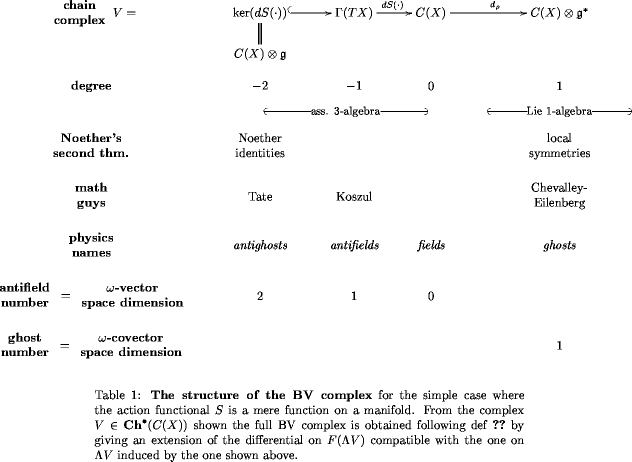Something Like Lie-Rinehart ∞-pairs and the BV-complex (BV, part VII)
Posted by Urs Schreiber
In the context of our previous discussion in Modules for Lie -algebras I am preparing some notes
On Lie -modules and the BV complex
Abstract. Some tentative remarks on generalizations of Chevalley-Eilenberg algebras from Lie algebras and their modules to Lie -algebras and their modules, with an eye towards understanding the Batalin-Vilkovisky complex.
While not finished, I thought that I would share this now as kind of a reply to some of the things Jim Stasheff, Todd Trimble, Johannes Huebschmann and others said.
Apart from getting the generalities right, like formulating everything as nicely as possible internal to the category of chain complexes, the point is to discuss the BV complex “for the (-1)-brane” which I talked about in BV for Dummies and in On Noether’s second and take it as the motivating and guiding example to obtain and check the right definition of a Lie -algebroid, such that its dual is an arbitrarily graded dg-algebra of sorts.
All comments are welcome. Especially corrections.
Previous entries in this BV series are I II III IV V VI.
By the way, a pretty good set of slides summarizing BV is
Glenn Barnich
Algebraic structure of gauge systems:
Theory and Applications
(pdf)
The toy example that I was talking about in BV for Dummies is essentially the one on slide 3 there.
Posted at November 20, 2007 7:55 PM UTC

the Tate construction
Concerning the section about the Tate construction:
I have the old 1956 paper by Tate here, as well as Sullivan’s old paper on rational homotopy theory. There the killing of cohomology groups is done very much in components, choosing bases, etc.
I guess in modern rational homotopy theory texts its done differently, but I am probably mostly ignorant of these, for the moment.
So I was wondering by myself: what is the nice way to formulate the Tate construction, where we start with a dg-algebra and find an extension of it by successively throwing in new generators, such that the extension has all cohomology groups vanishing, except for the lowest one, which coincides with that of .
I am thinking: the step “throw in new generators” is really: form a mapping cone.
Namely if is may cochain complex and its cocycles in degree n, then there is the canonical inclusion
and the Tate step of “killing” the cohomology amounts to forming the mapping cone
and then extending that again to a quasifree dg-algebra.
While this looks right, it is quite likely just scratching the surface.
So I have this question:
what is the nice modern abstract neat way to think of the Tate construction?